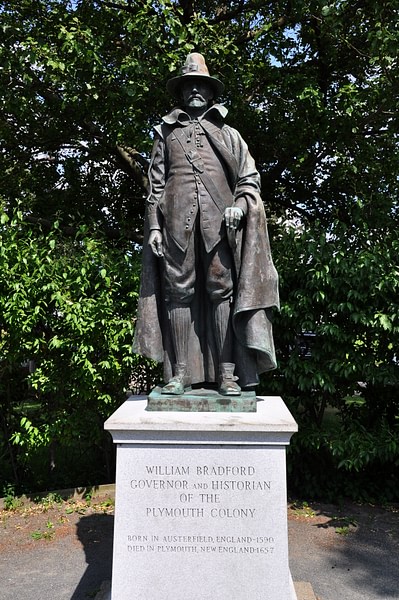
William Bradford (l. 1590-1657 CE) was one of the leading members of the congregation of pilgrims who came to North America aboard the Mayflower, a signer of the Mayflower Compact, and the second governor of the Plymouth Colony after the death of the first, John Carver (l. 1584-1621 CE), in 1621 CE. Bradford would hold this position for the next 30 years and was so influential that he was often referenced as the first governor of Plymouth and continues to be even in the modern era.
He lost his family by age 7 and went to live on his uncle's farm where he worked as a laborer. Shortly afterwards, he came down with an unknown illness which kept him bedridden, and during this time he read the Bible and various other works, which significantly influenced him. He found he could not reconcile the simplicity and purity of the biblical account of the first Christian community (as given in the Book of Acts) with the rituals of the Anglican Church of his uncle and extended family, and when he was 12, he embraced the Puritan vision.
He became involved with a Puritan separatist congregation and met William Brewster (l. 1568-1644 CE), one of the congregants, who influenced him further. These meetings were illegal as they had been banned by King James I of England (r. 1603-1625 CE) who, as king, was head of the Anglican Church. For their own safety and freedom of worship, the group decided to relocate to the Netherlands.
After 12 years in Leiden, the Netherlands, they again needed to move to escape the persecution of King James I and arranged passage to North America. Bradford was instrumental from the beginning in establishing the settlement and was elected governor after Carver's death in April of 1621 CE, instituting policies which enabled growth, inclusion, and peaceful coexistence with the Native Americans.
Ten years after the colony was established, Bradford would begin writing Of Plymouth Plantation, his narrative of the events that brought the pilgrims to the so-called New World, a work considered a classic of Early American Literature and among the most important primary sources on the founding and development of the English colonies. He is remembered today as one of the most influential figures of Colonial America whose work, whether as governor or writer, helped shape the foundation of the United States of America.
Anglicans, Puritans, & Bradford's Early Life
The Anglican Church was founded during the Protestant Reformation by King Henry VIII of England (r. 1509-1547 CE) and, by Bradford's time, was well-established and engaged in its own persecutions of Christian fundamentalists known as Puritans. The Puritans objected to the Anglican retention of aspects of Catholicism, which they claimed were unbiblical, especially the use of the Book of Common Prayer, which they felt separated a believer from God.
The goal of the Puritans was to purify the Anglican Church of any beliefs and practices not supported directly by the Bible, but Queen Elizabeth I of England (r. 1558-1603 CE), and then James I, ignored their petitions, and James I initiated persecutions of religious dissenters, equating criticism of the Church with treason. This was the religious and cultural atmosphere in which young William Bradford grew up, a member of the Anglican Church, in Austerfield, England.
Bradford was born to William Bradford, Sr. and Alice Briggs and was baptized at St. Helena's Church in Austerfield in March 1590 CE. The family was descended from nobility and were farmer-landowners. His father died when he was a year old, and when his mother remarried three years later, he was sent to live with his grandfather, William Bradforthe, who died two years later. Bradford then returned to live with his mother and stepfather until his mother died in 1597 CE and he was sent to live and work on his uncle's farm.
It is unknown how long he may have worked there or what his chores were, but at some point after his arrival, he fell ill and was confined to his bed. He read the Geneva Bible, the translation published in 1560 CE and heavily influenced by the theology of John Calvin (l. 1509-1564 CE), Foxe's Book of Martyrs (describing the faith, trials, and deaths of early Christian saints), and many other works. By the age of 12, he was convinced that the Anglican Church did not represent the spiritual vision of the Bible or early Christianity and began to look for an alternative.
The Scrooby Congregation
A popular, and illegal, sect of the time was Brownism, founded and advanced by a former Anglican priest named Robert Browne (l. 1550-1633 CE) who claimed the Anglican Church was completely corrupt and irredeemable. There was no point in trying to purify it; a true believer must leave it behind and seek divine truth only from the Bible and direct communion with God. Browne's followers became known as Brownist Separatists following the injunction from II Corinthians 6:17 regarding Christians associating with the forces of darkness: “Come out from among them and be ye separate”.
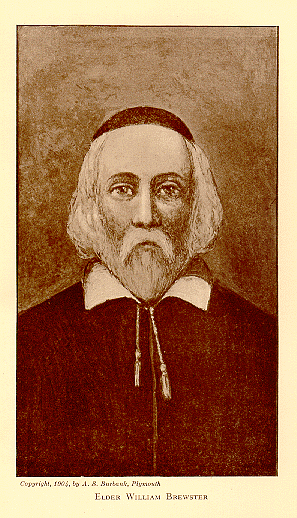
Self-Exile to Leiden
In 1607 CE, the Anglican Archbishop Tobias Matthew (l. 1546-1628 CE) became aware of the illegal Scrooby congregation and had a number of them arrested. Bradford himself was fined, but others faced far worse punishments, and those not accused and convicted found themselves under almost constant surveillance. They decided to leave Scrooby for the more tolerant Netherlands. Bradford was only 17 at the time, son of a landowner who stood to inherit his father's lands in a year and with a secure job on his uncle's farm, but the Scrooby congregation was the only real family he had ever known and so he chose to leave with them. Once the congregation had all arrived in Amsterdam, they found other separatist congregations there embroiled in various contentions and scandals and so moved further away to the city of Leiden.
Here they were finally able to worship freely and live as they wished. They were foreigners in a land whose guilds favored nationals, however, and could only hold the most menial jobs. Further, the longer they were there, the more acclimated their children became to Dutch culture, and the congregation, all proud English, feared losing their heritage.
Bradford, a former landowner of means, was now forced to work as a weaver and, instead of following the natural course of a day in farm work, was summoned to his job by a bell, worked all day, and was dismissed in the evening by the same. He inherited his father's property when he turned 21 and was able to buy a house and married Dorothy May (l. c. 1597-1620 CE), the niece of William White (l. c. 1580 - winter of 1620/1621 CE) of the Leiden congregation; the couple would have one son, John. Even though the congregants could worship freely, as a whole, they were becoming increasingly uneasy about continuing on in the Netherlands.
They were already raising money and researching passage to the New World in 1617 CE but, the following year, the decision was made for them. In 1618 CE, William Brewster published a tract criticizing the Anglican Church, and James I and officials were sent to arrest him. He was hidden by the congregation, but efforts now needed to intensify to move faster and further away from the reach of James I. Two members of the congregation, John Carver and Robert Cushman (l. 1577-1625 CE), made contact with a merchant adventurer named Thomas Weston (l. 1584 - c. 1647 CE), a man who matched would-be colonists with investors, who put together a deal for them.
England had established its first successful colony in the Americas at Jamestown in 1607 CE in the region known as the Virginia Patent, and Weston's arrangement was to bring members of the congregation, and only them, to an area north of Jamestown where they would establish a settlement and work to pay off the investors with interest. As negotiations went on, however, Weston kept changing the details until, finally, the separatists were required to travel with others, not of their faith, hired by Weston to make sure the colony succeeded; the separatists called these others the Strangers.
Voyage & Arrival
Among the Strangers was Captain Myles Standish (l. c. 1584-1656 CE), who was known by the Leiden congregation and well-liked, but most of the others were unknown Anglicans, and some, like Christopher Martin (l. c. 1582 - winter of 1620/1621 CE), were openly hostile to the separatists. Two ships were acquired for the crossing – the Speedwell, a passenger ship, and the Mayflower, a cargo carrack – and the party was supposed to leave in June 1620 CE. Various problems with Weston and Martin delayed departure, and then, once underway, the Speedwell leaked and had to be abandoned, necessitating some 20 passengers from that ship to board the already-cramped Mayflower. Bradford and Dorothy left their three-year-old son John behind with the congregation of Leiden to be sent for later and left on the Mayflower.
Bradford describes the trip across as beginning well, “with a fair wind”, then devolving into a journey of almost constant danger, high waves and wind, constant seasickness among the passengers, and living in the half-light of the `tween deck, with no open windows, between the main deck and cargo hold. The captain of the Mayflower was Christopher Jones (l. c. 1570-1622 CE), regarded highly by Bradford, who repeatedly saved the ship and brought them to land in the Americas on 9 November 1620 CE after a little over two months at sea.
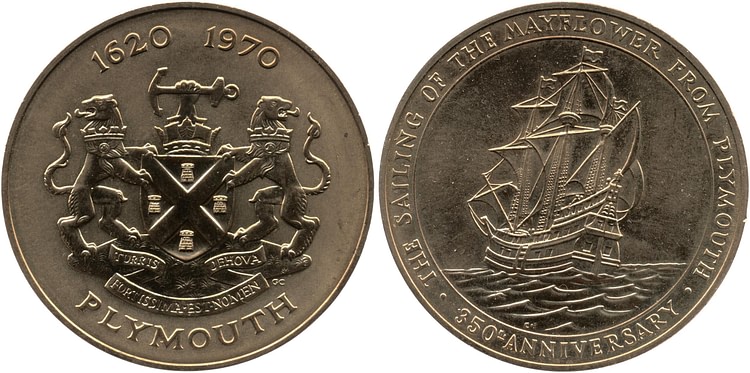
This agreement became known as the Mayflower Compact, signed by 41 of the men onboard, stipulating a democracy which would enact laws to be voted on by every male over the age of 21. The Mayflower Compact ensured the colony's survival in that, now, everyone would have a voice in a government agreed upon for the common good. Their first act was to elect John Carver their governor, giving him the authority to delegate responsibilities, and he began by ordering expeditions to find a suitable place for the settlement.
Bradford volunteered for this mission and went out with other men in the shallop (a small boat) to explore. On his first foray, he was caught in a deer trap set by Native Americans, and on the third, their boat nearly sank. They finally located a suitable spot at an abandoned Native American village of the Patuxet tribe, which they named Plimouth (later Plymouth) after the city they had sailed from in England (though it was already known as New Plimouth on maps made in 1614 CE by Captain John Smith). While Bradford was away, on 7 December, Dorothy fell from the main deck of the Mayflower and drowned.
A 19th-century CE work of historical fiction would later claim she killed herself in shame after an affair with Captain Jones, and this interpretation of her death is still repeated in the modern era even though it is baseless. At the same time, however, it has been noted that there were many aboard the Mayflower when Dorothy would have gone overboard, and had she wanted to be saved, she would have made some effort at attracting attention, suggesting suicide. Bradford only notes that she drowned on 7 December 1620 CE without elaboration.
First Winter & Governorship
Dorothy Bradford was among the first to die in the new land but was far from the last. The colonists were unprepared for the harsh winter of 1620-1621 CE, and 50% of the passengers and crew were dead before spring. Bradford, who fell ill himself, records how, at one point, there were only seven healthy members of the party who devoted themselves ceaselessly to caring for the sick without complaint or hesitation, noting Myles Standish among them. The survivors of the winter carried on in spring with the construction of homes along the first thoroughfare in the new settlement: Leiden Street.
Bradford and the others were still struggling, however, as the seed they had brought from England was not doing well until help arrived in the form of the Native American Samoset (also given as Somerset, l. c. 1590-1653 CE) who introduced them to Tisquantum (better known as Squanto, l. c. 1585-1622 CE). Squanto supplied the colonists with better seed and taught them how to plant beans, corn, and squash as well as how to fish and hunt game. He was fluent in English, having been kidnapped by the English years before to be sold into slavery, and was able to interpret between the colonists and Ousamequin (Massasoit Sachem, l. c. 1581-1661 CE), chief of the Wampanoag Confederacy.
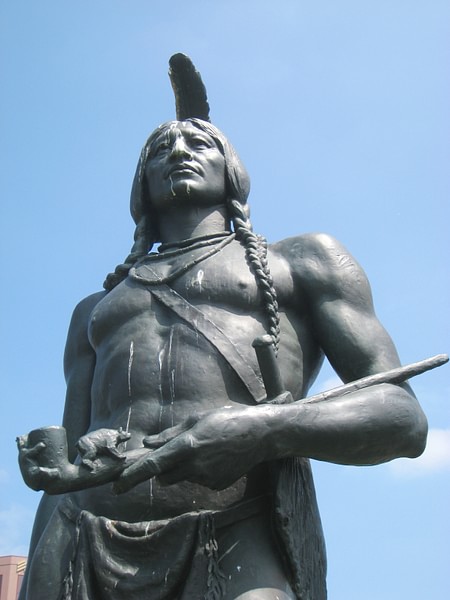
He could be severe in his punishments but only with just cause and in accordance with the law while also emphasizing religious tolerance and creating policies which benefited all and favored no one. Non-separatists were not required to attend church services or Bible study, and as more colonists arrived throughout 1621 CE, they were welcome at Plymouth regardless of their religious affiliation. In the autumn of 1621 CE, Bradford presided over the harvest feast which, according to tradition, included Strangers, separatists, and Native Americans in what has come to be called the First Thanksgiving.
He established the tradition of town meetings where anyone could voice a grievance or concern, organized farming, trade contracts, and after the Puritan Massachusetts Bay Colony established itself nearby in 1630 CE, which held to a more rigid view of Christianity than the people of Plymouth, he worked to keep the two separate and maintain the welcoming and more liberal atmosphere of his colony. He was extremely effective as governor and held the position for the rest of his life.
Among his most dramatic and significant acts was the 1627 CE distribution of land in Plymouth. Every free male colonist (not a servant) over the age of 21 was given a certain amount of land to farm and call their own. Plymouth still owed Weston and the investors for financing their voyage, and Bradford understood that not everyone's farm would do equally well to help pay off the debt; he, therefore, assumed the debt personally (along with four others) in order to take the burden off the colonists. The debt would finally be paid in 1648 CE, 28 years after the Mayflower landed, but by his actions Bradford encouraged economic and agricultural growth which might otherwise have been impossible and also created the free market in that personal farms which employed more effective methods of growth did better financially, encouraging others to compete with them for profits.
Conclusion
Starting in 1630 CE, in addition to his many responsibilities as governor, Bradford began writing Of Plymouth Plantation. This book, along with another earlier work known as Mourt's Relation (written by Bradford and Winslow), recounts the journey across the Atlantic and the early years of the Plymouth Colony; almost all of what is known of Bradford's life comes from these works.
Bradford married Alice Southworth, who arrived with other colonists on the ship the Anne, in 1623 CE (the same ship that brought his son John) and they would have three children, two of whom would go on to start families of their own and continue the Bradford name. After serving his community and God faithfully, William Bradford died at the age of 67 in 1657 CE and was interred with full honors on Burial Hill in Plymouth. He is remembered as the guiding force of the early colony due to his emphasis on tolerance, personal responsibility for the common good, and justice for all, no matter one's religious beliefs, all of which would influence the later vision of the Founding Fathers of the United States.
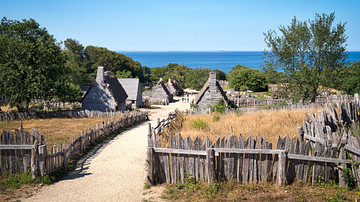
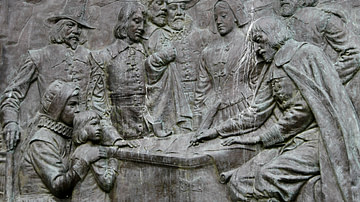
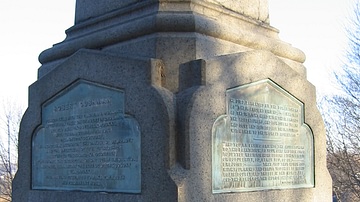
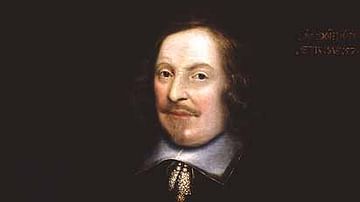
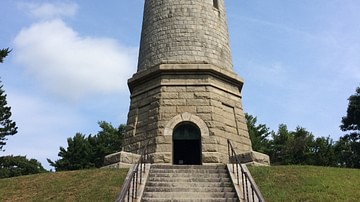
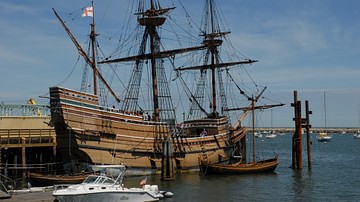
![[Mayflower: A Story of Courage, Community, and War] [By: Philbrick, Nathaniel] [April, 2007]](https://m.media-amazon.com/images/I/51tPkcPE8JL._SL160_.jpg)



